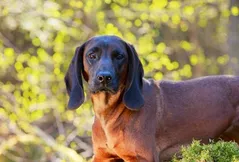
Lakeland Terrier
The mischievous Lakeland struts like a rooster and has a sense of humor second to none. He is also friendly, confident and bold.
Overall Status
| Height | 14.5 inches at the shoulder |
| Temperament | Friendly, Confident, Bold |
| Weight | 15 to 17 pounds |
| Life Expectancy | 12 to 15 years |
| Coat Color | Black, Black and Tan, Blue, Brown, Red |
| Barking Level | Likes To Be Vocal |
Quick Factors
| Playfulness | |
| Dog Friendly | |
| Exercise Need | |
| Grooming Needs | |
| Strangers Friendly | |
| Family Affectionate |
Daily Care
Grooming Tips
The Lakeland has a double coat: hard and wiry on the outside with a soft undercoat next to the skin. The hair is slightly wavy or straight. For the show ring, the coat is hand-stripped to show the dog’s outline, giving him a neat and workmanlike appearance.If you want your Lakeland to have the distinctive grooming of the breed, you're going to have to learn to do it yourself or find a groomer who is familiar with the task – which can be something of a challenge. Theshow coatis are even more difficult to achieve. Most pet owners simply comb their dogs a couple of times a week and clip them every couple of months. The U. S. Lakeland Terrier Club has an extensivearticleon how to care for the coat of a pet Lakeland Terrier.The rest is basic care. Trim the nails as needed, usually once every week or two. Brush the teeth frequently with a vet-approved pet toothpaste for good overall health and fresh breath.Check the ears weekly for dirt, redness or a bad odor that can indicate an infection. If the ears look dirty, wipe them out with a cotton ball dampened with a gentle, pH-balanced ear cleaner recommended by your veterinarian. Introduce your Lakey to grooming early so that he will accept it willingly and patiently.
Exercise Tips
A great dog for an active family, the Lakeland Terriers has energy to spare. Don’t let their size fool you – even though he’s small, he won’t thrive in an apartment.Your Lakie will need to be outdoors as much as possible – and always attended. A yard must be large enough for him to run around in. Mix up your activities to keep your dog entertained.You can take him for walks, jogs, hikes, games of catch and trips to the dog park. Lakies do well with agility and Earthdog training, which gives them plenty of mental and physical stimulation. Remember, a bored Lakie becomes a destructive Lakie.
Feeding Tips
Like most breeds, the Lakeland Terrier does well on a diet of high-quality kibble, about one cup a day that’s divided into two meals. Lakeland Terriers can be possessive of their food, but obedience training will help curb this habit.Any diet should be appropriate to the dog’s age (puppy, adult, or senior). Some dogs are prone to gettingoverweight, so watch your dog’s calorie consumption and weight level.Treatscan be an important aid in training, but giving too many can cause obesity. Learn about whichhuman foodsare safe for dogs, and which are not.Check with your vet if you have any concerns about your dog’s weight or diet.Clean, fresh water should be available at all times.
Health Tips
There are very few breed health conditions specific to the Lakeland Terrier, and none that have been reported at more than a very low incidence.As with all breeds, a Lakeland’s ears should be checked regularly for signs ofinfection, and theteethshould be brushed often, using a toothpaste designed for dogs.
Trainability
Thanks to his independent streak, the Lakeland Terrier can be a challenge to train. You’ll need to be patient, as well as firm and consistent, to ensure training goes well. Use positive reinforcement techniques such as food rewards, praise, and play to get the most out of your lessons. As well, lessons should be short and entertaining so that your Lakie doesn’t lose interest. Always be consistent with training and discipline (but never harsh) in order to establish your role as the leader of the household.After basic training has been mastered, your Lakeland Terrier will flourish with advanced training and agility activities. This will help keep his mind and body alert and active.You may find that housetraining can be trying. Again, this is when patience and consistency are needed. Stick to a bathroom schedule and make sure a job well done is rewarded with praise and treats. You’ll want to crate train your Lakie to help curb indoor accidents.
History
The Lakeland Terrier breed dates back to the 1800s and is one of the oldest terrier breeds that is still around today. The breed was originally called the Patterdale Terrier, however, it is a separate breed from thePatterdale Terrierthat we know of today.The Lakeland was developed by crossing theBedlington Terrier, with the Old English Wirehaired Terrier in the Lake District of England. The dog was used to prevent fox and other vermin from destroying the crops and herds. It hunted den animals such as badger, fox and otter.It was able to hunt on uneven terrain, woods, fields and water. It chased and killed the quarry. The Lakeland was recognized as a breed in 1921 and by the AKC in 1934. It is still used for hunting, as a companion and as a show dog. Some of the Lakeland Terrier’s talents include: hunting, tracking and watchdog.






